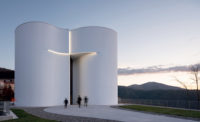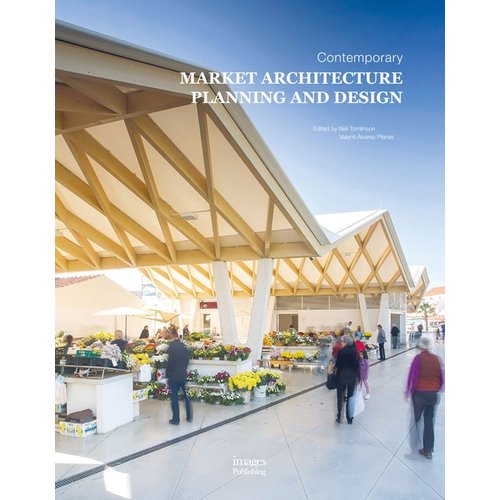Sustainability in Practice
Mario Cucinella's Architectural Autobiography Investigates How Design Can Learn from the Natural World
Excerpt: 'The Future is A Journey to The Past, Ten Stories About Architecture' by Mario Cucinella

Architects & Firms
Mario Cucinella is founder of Milan- and Bologna-based Mario Cucinella Architects (MCA), as well as the SOS School of Sustainability. In his most recent book, the Italian designer has compiled an architectural autobiography of 10 travel stories, spanning from Iran and China to Ireland and the Maghreb, that offer lessons on how architecture can learn from the natural world. “They are not nostalgic tales,” he says, “but the discovery of a past in which to seek lots of information that can help us in our journey to the future.” Following is an excerpt from the preface.

The Future is a Journey to the Past, by Mario Cucinella. Quodlibet, 128 pages, $15.
For thousands of years, we have found a way to adapt to places, going from a nomadic period, when houses could be transported in a sort of prelude to prefabrication, to permanent homes, with all that this has meant for the social organization of civilization.
We decided we wanted to live together, perhaps for the sake of convenience. Those more fortunate were able to build a house for themselves, then many of them together created a village, and after that many villages breathed life into a city. But these cities, these places where people resided, were all different, made with different materials, which did not mean they were less beautiful or spectacular. What made all these cities so different?
They were built in places that were the most unthinkable, the most insidious, in the most extreme climate situations. Nonetheless, cities had never been extraneous to a relationship with the countryside and with the landscape—primordial resources—and indeed this relationship was an indispensable part of their very essence.
This extraordinary idea of living together can have many reasons, the most credible one being related to sociality. From the city, politics were born—from the Greek politiké, where the polis is the “city,” the “society,” and téchne refers to the government. Thus were born a life in common and an ancestral relationship with nature, which we both need and fear. The Italian word comune itself derives from the concept of the community, of living together, and it was assumed that the territory’s resources were also in common.

Designed by MCA to house the administrative offices and research laboratories of the Regional Agency for the Environment and Energy, in Ferrara, Italy, the ARPAE building (above) is capped by a matrix of 112 chimneylike wood volumes. These serve two purposes—mediating daylight and improving airflow. Photo © Moreno Maggi, click to enlarge.
I am increasingly intrigued by the world of plants, which are in the majority on this planet. Permanently located by nature, over the course of millennia they have had to adapt, be transformed, build up defenses, reproduce, fight, be joyful, and exploit the surrounding environment. They underlie the planet’s ecosystem. As a result, there are plants at every latitude, even in the most extreme places, such as deserts or ice caps.
This story about plants and architecture is much more than a journey. This story is a rediscovery of the deep reasons for the lost relationship between humans and the planet (along with its climates) and the planet’s ability to adapt and construct.
The amazing tales that [Stefano] Mancuso describes in the [2014] book Uomini che amano le piante [Men Who Love Plants] tell of a different intelligence from ours, but one that is present, capable of reacting to what is around us and of finding solutions for adaptation. If you think of it, as Professor Mancuso tells us, humans are infinitely younger than plants: they did not appear until 470 million years later. Humans have had to learn to adapt, to use the available resources, to build communities, villages, cities in harmony with the environment.
But what can we still learn today from the plant world?
Is it possible that we still haven’t learned the deep secret of the world around us?
Somehow we discover that we don’t really know profoundly enough what we have—the land we live on. And yet we could learn many things rather than invent useless and costly stratagems.
Architecture has abandoned this path of empathy with the planet for some time now, with impressive and dramatic results. Instead of reacting to places in an intelligent way, it has decided, thanks to its boundless faith in technology, not to consider and not to use the energy that is available. We could discuss this at length, but we are anxious to set off on our journey.
Naturally, buildings are not as intelligent as plants, but in this case we can contribute to making them intelligent by designing them more carefully. And perhaps tomorrow we will also be able to think about an evolutionary form for the building as an organism capable of reacting to outside conditions, for instance, by using intelligent materials.
How does a cactus thrive in the desert? Where does its ability to adapt to the climate lie? Just like us, plants build communities, but how do they know how to do that? No doubt the reader can find out if they examine the topic more closely through the research conducted by Mancuso, an expert on plant neurobiology.
For my part, I view with great interest the telling the tale of these 10 cities, which do not want to be solely a tale of technical aspects, or aesthetics, but rather an indication of a future where we will have to find the key to open the door to our friendship with the planet.
Architecture leaves traces. It is the heritage of the millennia that over the past century we have treated as though it were archaeology, often reserved for specialists. This is why the journey is so important. Many places are known, others less so, and many others only exist in the tales of the writers. All the same, they are there to tell us that all we need to do is look carefully behind the curtains of the story to find the solutions for our future.







